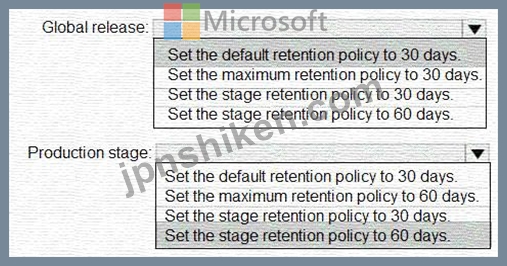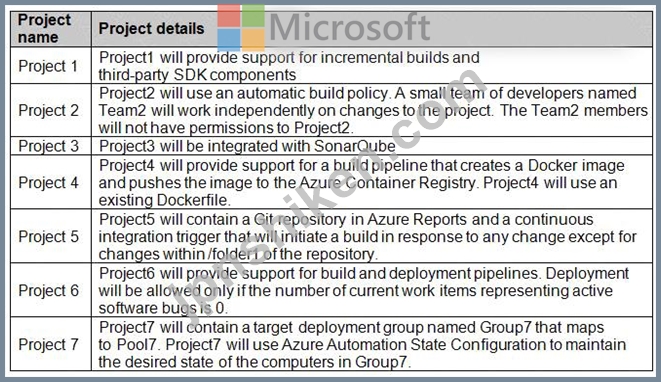- ホーム
- Microsoft
- AZ-400J - Designing and Implementing Microsoft DevOps Solutions (AZ-400日本語版)
- Microsoft.AZ-400J.v2024-02-22.q208
- 質問142
有効的なAZ-400J問題集はJPNTest.com提供され、AZ-400J試験に合格することに役に立ちます!JPNTest.comは今最新AZ-400J試験問題集を提供します。JPNTest.com AZ-400J試験問題集はもう更新されました。ここでAZ-400J問題集のテストエンジンを手に入れます。
AZ-400J問題集最新版のアクセス
「559問、30% ディスカウント、特別な割引コード:JPNshiken」
投資計画アプリケーションスイートのリリース保持ポリシーをどのように構成する必要がありますか?回答するには、回答領域で適切なオプションを選択します。
注:それぞれ正しい選択は1ポイントの価値があります。

注:それぞれ正しい選択は1ポイントの価値があります。

正解:

Explanation

Scenario: By default, all releases must remain available for 30 days, except for production releases, which must be kept for 60 days.
Box 1: Set the default retention policy to 30 days
TheGlobal default retention policy sets the default retention values for all the build pipelines. Authors of build pipelines can override these values.
Box 2: Set the stage retention policy to 60 days
You may want to retain more releases that have been deployed to specific stages.
References:https://docs.microsoft.com/en-us/azure/devops/pipelines/policies/retention
Topic 2, Contoso Case Study: 2
Overview
Existing Environment
Contoso, Ltd. is a manufacturing company that has a main office in Chicago.
Requirements
Contoso plans to improve itsIT development and operations processes implementing Azue DevOps principles.
Contoso has an Azure subscription and creates an Azure DevelPs organization.
The Azure DevOps organization includes:
* The Docker extension
* A deployment pool named Pool7 that contains 10 Azure virtual machines that run Windows Server
2016.
The Azure subscription contains an Azure Automation account.
Planned Changes
Contoso plans to create projects in Azure DevOps as shown in the following table.

Technical Requirements
Contoso identities the following technical requirements:
* Implement build agents rot Project 1.
* Whenever possible, use Azure resources
*Avoid using deprecated technologies
* Implement a code flow strategy for Project2 that will:
*Enable Team 2 to submitpull requests for Project2.
* Enable Team 2 to work independently on changes to a copy of Project?
* Ensure that any intermediary changes performed by Tram2 on a copy of Project2 will be subject to the same restrictions as the ones defied in the build policy of Project2.
* Whenever possible. Implement automation and minimize administrative effort.
* Implement Protect3, Project5, Project6, and Project7 based on the planned changes.
* Implement Project4 and configure the project to push Docker images to Azure Container Reentry.
- 質問一覧「208問」
- 質問1 az400-9940427-func1 という名前の App Service プランでホスト...
- 質問2 次の表に示すアプリ用の YAML ベースの Azure パイプラインを設...
- 質問3 注:この質問は、同じシナリオを提示する一連の質問の一部です。
- 質問4 プロビジョニングされたデバイスとプロビジョニングされていない
- 質問5 Azure DevOps に Project1 という名前のプロジェクトがあります...
- 質問6 あなたの会社はソース管理にGitHubを使用しています。 GitHubリ...
- 質問7 az400-9940427-main という名前の Azure Application Insights ...
- 質問8 注:この質問は同じシナリオを提示する一連の質問の一部です。連
- 質問9 このセクションの質問に回答した後は、その質問に戻ることはでき
- 質問10 注:この質問は、同じシナリオを提示する一連の質問の一部です。
- 質問11 (Exhibit) Azure Kubernetes Service (AKS) ポッドがあります。 ...
- 質問12 複数のパブリックフィードからのパッケージを使用するプロジェク
- 質問13 Application Insights を使用してアプリケーションのパフォーマ...
- 質問14 あなたの会社はJavaで新しいソリューションを構築しています。 ...
- 質問15 Windows Server 2019を実行するAzure仮想マシンがいくつかありま...
- 質問16 Azure DevOpsを使用して、App1という名前のアプリのビルドとデプ...
- 質問17 Contoso という名前の Azure DevOps 組織があります。 作業項目...
- 質問18 注:この質問は、同じシナリオを提示する一連の質問の一部です。
- 質問19 Azure仮想マシンを使用する新しいアプリケーションをデプロイし...
- 質問20 この質問は、同じシナリオを提示する一連の質問の一部です。 シ
- 質問21 投資計画のディプリーションスイートのリリース保持ポリシーをど
- 質問22 Azure Reposで新しいGitリポジトリの設定を構成しています。 マ...
- 質問23 Docker Trusted Registryでホストされているイメージから展開さ...
- 質問24 次の表に示すリソースを含むAzureサブスクリプションがあります...
- 質問25 注:この質問は、同じシナリオを提示する一連の質問の一部です。
- 質問26 あなたの会社は新しいWebアプリケーションを構築しています。 提...
- 質問27 You have an Azure subscription that contains multiple Azure ...
- 質問28 AzureDevOpsにProject1という名前のプロジェクトがあります。 Pr...
- 質問29 あなたの会社には、サードパーティのパブリッククラウドでLinux...
- 質問30 注:この質問は、同じシナリオを提示する一連の質問の一部です。
- 質問31 注: この質問は、同じシナリオを示す一連の質問の一部です。この...
- 質問32 あなたの会社は、アプリケーションを以下のエンドポイントにデプ
- 質問33 AzurePipelinesでビルドパイプラインを作成しています。 サード...
- 質問34 複数の Azure パイプラインを含む Azure サブスクリプションがあ...
- 質問35 az400-9940427-main という名前の Azure Application Insights ...
- 質問36 50 台の仮想マシンを含む Azure サブスクリプションがあります A...
- 質問37 Windows Serverを実行するAzure仮想マシンのベースラインメトリ...
- 質問38 注:この質問は、同じシナリオを提示する一連の質問の一部です。
- 質問39 Azure Pipelinesにビルドパイプラインがあり、失敗することがあ...
- 質問40 2 つの Azure リージョンでホストされる Web サイトをデプロイす...
- 質問41 Web ブックを含む Azure Automation アカウントがあります。Webb...
- 質問42 あなたの会社はアジャイル開発方法論を実装しています。 各スプ
- 質問43 Azure DevOps にプロジェクトがあります。 プル リクエストに関...
- 質問44 注:この質問は、同じシナリオを提示する一連の質問の一部です。
- 質問45 Azure DevOps ビルド パイプラインを含む Azure サブスクリプシ...
- 質問46 Azure Automation State Configurationで仮想マシンを管理対象ノ...
- 質問47 Azure AD ユーザー アカウントを作成する Runbook をデプロイす...
- 質問48 注:この質問は、同じシナリオを提示する一連の質問の一部です。
- 質問49 大きな PSD ファイルを含む Azure Repos リポジトリがあります。...
- 質問50 注: この質問は、同じシナリオを示す一連の質問の一部です。この...
- 質問51 Project1のビルドエージェントを実装するための手順を推奨する必...
- 質問52 あなたの会社は、開発者がオープンソース ライブラリを導入する
- 質問53 Azure パイプラインを使用してビルド アーティファクトを公開す...
- 質問54 ワークフローを含む GitHub リポジトリがあります。ワークフロー...
- 質問55 Azure Artifactsを使用して、作成、テスト、検証、および展開し...
- 質問56 あなたの会社はAzureとAzure Stackの間にハイブリッドクラウドを...
- 質問57 あなたは会社のテストプロセスを自動化しています。 Web アプリ...
- 質問58 次の展示に示すように、AzureMonitorでアラートルールを作成しま...
- 質問59 あなたの会社は、パッケージ管理にAzure Artifactsを使用してい...
- 質問60 Azure DevOps にプロジェクトがあります。 Template1.yml という...
- 質問61 注:この質問は同じシナリオを提示する一連の質問の一部です。連
- 質問62 複数のAzureActive Directory(Azure AD)アカウントがあります...
- 質問63 Azure Pipelines に Pipeline1 という名前のパイプラインがあり...
- 質問64 あなたはProject4を実装する必要があります。 あなたは最初に何...
- 質問65 Azure DevOps プロジェクトがあります。 Azure Resource Manager...
- 質問66 ビルドとリリースのパイプラインは、Azure DevOpsを使用して管理...
- 質問67 Azure DevOps に Project1 という名前のプロジェクトがあります...
- 質問68 注:この質問は、同じシナリオを提示する一連の質問の一部です。
- 質問69 あなたは、Azure DevOpsを使用してインフラストラクチャをAzure...
- 質問70 GitHubコードの移行を実行する必要があります。ソリューションは...
- 質問71 あなたの会社では、Java ベースのプロジェクトのビルド パイプラ...
- 質問72 Azure Application Insightsを使用して、AzureWebアプリの正常性...
- 質問73 db1 という名前の Azure SQL Database を使用するアプリがいくつ...
- 質問74 開発チームは、Microsoft Visual Studioの統合開発環境(IDE)を...
- 質問75 Azure AppServiceでホストされているWebアプリがあります。 Web...
- 質問76 コード資産には Calendar Versioning (CalVer) を使用します。 ...
- 質問77 Azure DevOps のプロジェクトで NuGet パッケージを使用する予定...
- 質問78 注:この質問は同じシナリオを提示する一連の質問の一部です。連
- 質問79 Azure Kubernetes Service(AKS)ポッドがあります。 次のアクシ...
- 質問80 このセクションの質問に回答した後は、その質問に戻ることはでき
- 質問81 Azure DevOps を使用して、Java ベースのアプリケーションのビル...
- 質問82 RG1lod11566895 という名前のリソース グループ内の db1 という...
- 質問83 db1 という名前の Azure SQL データベースに接続する Web アプリ...
- 質問84 ソース管理とプロジェクト関連のディスカッションにはGitHubを使...
- 質問85 あなたの会社は次のリソースを使用しています。 * Azure Contain...
- 質問86 ドラッグドロップ Contoso という名前の Azure DevOps 組織があ...
- 質問87 電子商取引 Web サイトをサポートする Azure Web アプリを管理す...
- 質問88 Azure サブスクリプションをお持ちです。 Bicep ファイルを使用...
- 質問89 注:この質問は同じシナリオを提示する一連の質問の一部です。連
- 質問90 次の要件を持つ新しいプロジェクトをAzureDevOpsにデプロイする...
- 質問91 Group 7のコンピューター用にAzure Automationを構成する必要が...
- 質問92 注:この質問は、同じシナリオを提示する一連の質問の一部です。
- 質問93 あなたの会社には4つのプロジェクトがあります。各プロジェクト
- 質問94 ホットスポット モバイル アプリケーションが共有を呼び出すため...
- 質問95 あなたの会社はGitベースのソース管理に使用されるオンプレミス...
- 質問96 注:この質問は同じシナリオを提示する一連の質問の一部です。連
- 質問97 次の表に示すリソースを含む Azure サブスクリプションがありま...
- 質問98 Project1という名前のプロジェクトを含むAzureDevOps組織があり...
- 質問99 GitHubリポジトリを使用するオープンソースソリューションを開発...
- 質問100 Azure DevOpsにProject1というプロジェクトがあります。事業! I...
- 質問101 このセクションの質問に回答した後は、その質問に戻ることはでき
- 質問102 あなたの会社には、ノード パッケージ マネージャー (npm) パッ...
- 質問103 WindowsServer2019のServerCoreインストールで実行されるサーバ...
- 質問104 このセクションの質問に回答した後は、その質問に戻ることはでき
- 質問105 (Exhibit) あなたの会社は新しい Web アプリケーションを構築し...
- 質問106 シミュレーション az400-9940427-main という名前の Azure Web ...
- 質問107 投資計画アプリケーションスイートのリリースパイプラインにコー
- 質問108 GitHub Actions を使用する GitHub ワークフローを作成する予定...
- 質問109 app.contoso.comのカスタムドメインを持つApp1という名前のアプ...
- 質問110 Azure DevOps に Project1 という名前のプロジェクトがあります...
- 質問111 Azure Boards プロジェクトと GitHub リポジトリを統合していま...
- 質問112 org1という名前のGitHub組織と、Tenant1という名前のAzureテナン...
- 質問113 VM1 という名前の仮想マシンのブート診断を保存するには、RG1lod...
- 質問114 多層アプリケーションを展開するAzure Resource Managerテンプレ...
- 質問115 ホットスポット PowerShell を使用して Azure Log Analytics ワ...
- 質問116 AzureDevOpsに既存のプロジェクトがあります。 プロジェクトのリ...
- 質問117 注:この質問は、同じシナリオを提示する一連の質問の一部です。
- 質問118 Azure DevOps には複数のプロジェクトに取り組む複数のチームが...
- 質問119 Azure DevOps プロセスを使用して、コードをビルドおよびデプロ...
- 質問120 パッケージフィードを含むAzure DevOpsプロジェクトを管理します...
- 質問121 Terraformを使用してAzureリソースグループをデプロイする予定で...
- 質問122 注:この質問は同じシナリオを提示する一連の質問の一部です。連
- 質問123 db1 という名前の Azure SQL データベースに接続する Web アプリ...
- 質問124 Azure DevOpsでは、Project3を作成します。 あなたはプロジェク...
- 質問125 あなたの会社はAzure ReposのGitリポジトリを使ってWebアプリケ...
- 質問126 アプリのソース コードを含む GitHub リポジトリがあります。 ソ...
- 質問127 あなたの会社は、大量のデータを処理するクライアントバンキング
- 質問128 Azure Pipelines を使用して、アプリケーション コードをビルド...
- 質問129 GitHubでのコードレビュー割り当ての使用を評価しています。 コ...
- 質問130 会社がAzureでWebアプリケーションをホストしています。 会社は...
- 質問131 次の表に示すリソースを含む Azure サブスクリプションがありま...
- 質問132 Extra Beam Fusion SIEM と Azure クラウド プラットフォームを...
- 質問133 注:この質問は、同じシナリオを提示する一連の質問の一部です。
- 質問134 Azure DevOpsにプライベートプロジェクトがあり、User1とUser2と...
- 質問135 あなたの会社は、AndroidデバイスとOSデバイスをターゲットにし...
- 質問136 Azure AppServiceでホストされているWebアプリがあります。 Web...
- 質問137 Azure DevOps にプロジェクトがあります。 Template1.yml という...
- 質問138 注:この質問は同じシナリオを提示する一連の質問の一部です。連
- 質問139 現在、DevOpsプロセスの一部としてJIRA、Jenkins、およびOctopus...
- 質問140 AzureにMicrosoftASP.NETCore Webアプリがあり、世界中からアク...
- 質問141 あなたは多層アプリケーションを開発しています。アプリケーショ
- 質問142 投資計画アプリケーションスイートのリリース保持ポリシーをどの
- 質問143 あなたの会社はインシデント管理にService Nowを使っています。 ...
- 質問144 Azure Pipelinesを使用して、アプリのビルドとデプロイを管理し...
- 質問145 KV1 という名前の Azure Key Vault と 3 つの Web サーバーがあ...
- 質問146 あなたの会社はOS用のアプリを開発しています。アプリのすべての...
- 質問147 Contosoという名前のAzureDevOps組織とartAzureサブスクリプショ...
- 質問148 Project1 という名前の Azure DevOps プロジェクトと Sub1 とい...
- 質問149 4 つの Azure 仮想マシンを含む Azure サブスクリプションがあり...
- 質問150 あなたの会社はWebアプリケーションを作成します。 アプリケーシ...
- 質問151 アプリケーションをホストするには、Azure Kubernetes Service(...
- 質問152 次の要件を満たすには、AzureDevOpsエージェントプールへのアク...
- 質問153 Feed1 という名前の Azure Artifacts フィードを参照する Projec...
- 質問154 Project1という名前のAzure DevOpsプロジェクトとSub1という名前...
- 質問155 App Centerを使用して、モバイルデバイス向けにAzure DevOps戦略...
- 質問156 Dockerデプロイモデルを使用するAzure DevOpsパイプラインのイン...
- 質問157 WhiteSource Boltを使用してNode.jsアプリケーションをスキャン...
- 質問158 シミュレーション VM1 という名前の仮想マシンのブート診断を保...
- 質問159 あなたの会社では、ソース管理の取得に Azure DevOps を使用して...
- 質問160 Pipeline1 という名前の Azure パイプラインと Repo1 という名前...
- 質問161 次の表に示すリソースを含む Azure サブスクリプションがありま...
- 質問162 計画された変更をサポートするには、既存のDevOpsツールを置き換...
- 質問163 GitHub EnterpriseServerをソースコードリポジトリとして使用し...
- 質問164 GitHubリポジトリのAzure Pipelinesにパイプラインを含むContoso...
- 質問165 AzurePipelinesとGitHubがソースコードリポジトリとして統合され...
- 質問166 注:この質問は、同じシナリオを提示する一連の質問の一部です。
- 質問167 ソースコードをAzureリポジトリのGitリポジトリに保存します。サ...
- 質問168 AzurePipelinesにビルドパイプラインを含むAzureソリューション...
- 質問169 GitHub Enterprise アカウントを持っています。 アカウント リポ...
- 質問170 注:この質問は、同じシナリオを提示する一連の質問の一部です。
- 質問171 認証を必要とするMicrosoftASP.NETアプリケーションを構築してい...
- 質問172 次の展示に示すように、AzureMonitorでアラートルールを作成しま...
- 質問173 Contosoという名前のAzure DevOps組織、Project1という名前のAzu...
- 質問174 注:この質問は、同じシナリオを提示する一連の質問の一部です。
- 質問175 Webapp1という名前のAzureWebアプリがあります。 失敗したWebapp...
- 質問176 あなたの会社はAzure DevOpsを使用して、アプリケーションのビル...
- 質問177 新しいデータベース環境を展開することを計画しています。ソリュ
- 質問178 次のAzureポリシーがあります。 (Exhibit) ポリシーをテナントの...
- 質問179 注:この質問は、同じシナリオを提示する一連の質問の一部です。
- 質問180 Contosoという名前のAzureDevOps組織とAzureサブスクリプション...
- 質問181 Contoso という名前の Azure DevOps 組織があります。 作業項目...
- 質問182 あなたの会社には、Subscription1という名前のAzureサブスクリプ...
- 質問183 チームの展示に示されているように、3つのチームを持つAzure Dev...
- 質問184 ソース管理には GitHub を使用します。 機密データを含むファイ...
- 質問185 az400-9940427-main という名前の Azure Web アプリのピーク平均...
- 質問186 注:この質問は、同じシナリオを提示する一連の質問の一部です。
- 質問187 次の表に示すように、2つのアプリケーションの承認方針を定義し
- 質問188 コードレビュー中に、Javaアプリケーションの品質の問題を発見し...
- 質問189 Azure Boards と統合された GitHub リポジトリがある Azure Boar...
- 質問190 投資計画アプリケーションスイートのビルドエージェントとリリー
- 質問191 WhiteSourceを使用してスキャンした50のNode.jsベースのプロジェ...
- 質問192 セルフホストのLinuxエージェントをプロビジョニングする予定で...
- 質問193 ソース管理には Get を使用します。 リポジトリのパフォーマンス...
- 質問194 多層アプリケーションがあります。アプリケーションのフロント
- 質問195 .NET Core ランタイム スラックを使用する webapp1 という名前の...
- 質問196 プライベートGitHubリポジトリがあります。 Azureボード上のリポ...
- 質問197 ホームページのページ読み込みパフォーマンスに基づいてトリガー
- 質問198 あなたの会社はソフトウェア開発にアジャイルなアプローチを使う
- 質問199 リリースパイプラインを持つAzureDevOpsのプロジェクトがありま...
- 質問200 次のAzureポリシーがあります。 (Exhibit)
- 質問201 継続的インテグレーション/継続的デプロイ (CI/CD) パイプライン...
- 質問202 .NET アプリケーションのソース管理には GitHub を使用します。 ...
- 質問203 次の表に示すように、Azure DevOpsで3つのプロジェクト用にAzure...
- 質問204 Azure Active Directory(Azure AD)テナントを含むAzureサブス...
- 質問205 あなたの会社はビルドにクラウドホストのJenkinsを使用していま...
- 質問206 アプリケーションのビルドプロセスの一環として、GitHubにあるAz...
- 質問207 あなたの会社は3つのモバイルアプリケーションのスイートを作成
- 質問208 Node.js アプリのデプロイに使用される Azure DevOps パイプライ...

